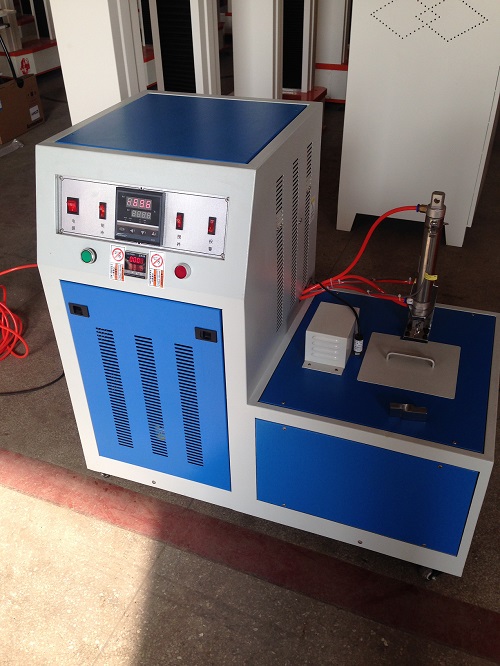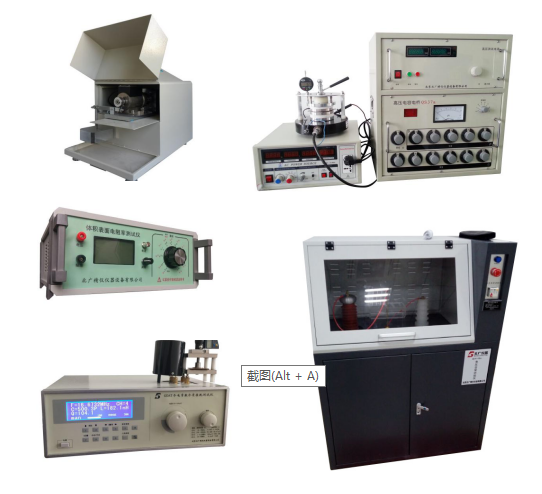
塑料低溫脆性沖擊試驗機(jī) 適用行業(yè):
可以用來考核和確定電工、電子、汽車電器、材料等產(chǎn)品,在低溫環(huán)境條件下貯存和使用的適應(yīng)性,適用于學(xué)校,工廠,軍工,研位,等單位。
塑料低溫脆性沖擊試驗機(jī) 結(jié)構(gòu)原理
A、本設(shè)備由制冷壓縮機(jī)主機(jī)體、加熱裝置、電子控制箱、冷卻槽、冷卻介質(zhì)循環(huán)系統(tǒng)、自動報警裝置等部分組成。啟動制冷開關(guān)后,壓縮機(jī)開始工作,制冷系統(tǒng)進(jìn)入正式工作狀態(tài)。制冷壓縮機(jī)連續(xù)不斷的工作,當(dāng)接近設(shè)定溫度時,冷卻槽中的加熱裝置開始按比例提供熱量,用以平衡制冷系統(tǒng)產(chǎn)生的多余冷量,以達(dá)到恒溫的目的。攪拌可使冷卻槽內(nèi)的冷卻介質(zhì)不斷循環(huán),使溫度均勻一致。
B、試樣夾持器
試樣一邊夾持4個試樣(橡膠類),另一邊夾持15個試樣(塑料類)。
C、沖擊裝置
沖擊裝置由沖擊錘和自鎖機(jī)構(gòu)組成。
D、沖擊器
沖擊頭半徑為1.6?0.1mm;
沖擊時,沖擊頭和試樣夾持器之間間隙為6.4?0.3mm;
沖擊頭的中心線與試樣夾持器之間的距離為8?0.3mm。
技術(shù)參數(shù):
A. 控溫范圍:室溫-70℃(室溫≤25℃)
B. 恒溫精度:?0.3℃
C. 降溫速度:0℃~﹣30℃ 約2.5℃/min
D. ﹣30℃~﹣40℃ 約2.5℃/min
E. ﹣40℃~﹣70℃ 約2.0℃/min
F. 最大外形尺寸:900?500?800mm(長?寬?高)
G. 工作室有效工作空間:280?170?120mm(長?寬?高)
H. 可裝試樣數(shù)量:1
I. 數(shù)字計時器數(shù)字計時器:0秒-99分鐘,分辨率1秒
J. 冷卻介質(zhì):乙醇或其他不凍液
K. 攪拌電機(jī):8W
L. 工作電源:220V--240V,50Hz,1.5kW
M. 工作溫度:≤25℃
注意事項
1在試驗過程中不能切斷冷卻循環(huán),否則會產(chǎn)生不制冷的效果。
2氣缸壓力在出廠前已調(diào)節(jié)好,不能任意變動。
試驗報告
A本標(biāo)準(zhǔn)名稱或編號
B樣品的詳細(xì)說明及其來源
C使用的傳熱介質(zhì)、致冷劑或其他降溫方式
D程序A:脆性溫度和試樣破壞現(xiàn)象
E程序B:規(guī)定的試驗溫度和試驗結(jié)果
試驗結(jié)果與處理
程序A
1、試樣出現(xiàn)破壞的最高溫度,就是該試樣的脆性溫度。
2、溫度值應(yīng)精確到1度。
程序B
如果一組試樣中沒有任何1個試樣破壞,則試驗結(jié)果為無破壞。如果一組試樣中有2個或2個以上試樣發(fā)生破壞,則試驗結(jié)果為破壞。如果一組試樣中只有一個試樣發(fā)生破壞,則再次取3個新的完好試樣測試,3個試樣均未發(fā)生破壞則試驗結(jié)果為無破壞;否則試驗結(jié)果為破壞。
傳熱介質(zhì)
在試驗溫度下,能保持流動,對試樣無附加影響的液體均可作傳熱介質(zhì)。這類傳熱介質(zhì)通常使用乙醇,此外還有丙酮、硅氧烷等。
致冷劑
可根據(jù)需要選用干冰或液氮。
注:也可采用其他降溫方式。
Applicable industries:
It can be used to assess and determine the adaptability of products such as electricians, electronics, automotive appliances, materials, etc. to storage and use in low-temperature environmental conditions, suitable for schools, factories, military industries, research institutes, and other units.
Structural Principles
A. This equipment consists of a refrigeration compressor main body, a heating device, an electronic control box, a cooling tank, a cooling medium circulation system, an automatic alarm device, and other parts. After starting the refrigeration switch, the compressor starts working and the refrigeration system enters the official working state. The refrigeration compressor operates continuously, and as it approaches the set temperature, the heating device in the cooling tank begins to provide heat proportionally to balance the excess cooling generated by the refrigeration system and achieve constant temperature. Stirring can continuously circulate the cooling medium in the cooling tank, ensuring a uniform and consistent temperature.
B. Sample holder
One side of the sample holds 4 samples (rubber type), and the other side holds 15 samples (plastic type).
C. Impact device
The impact device consists of an impact hammer and a self-locking mechanism.
D. Impactor
The radius of the impact head is 1.6 ? 0.1mm;
During impact, the gap between the impact head and the sample holder is 6.4 ? 0.3mm;
The distance between the centerline of the impact head and the specimen holder is 8 ? 0.3mm.
Technical parameters:
A. Temperature control range: room temperature -70 ℃ (room temperature ≤ 25 ℃)
B. Constant temperature accuracy: ? 0.3 ℃
C. Cooling rate: 0 ℃~-30 ℃, about 2.5 ℃/min
D. -30 ℃~-40 ℃, about 2.5 ℃/min
E. -40 ℃~-70 ℃, about 2.0 ℃/min
F. Maximum external dimensions: 900 x 500 x 800mm (length x width x height)
G. Effective workspace of the studio: 280 x 170 x 120mm (length x width x height)
H. Number of samples that can be loaded: 1
I. Digital timer: 0-99 minutes, resolution of 1 second
J. Cooling medium: ethanol or other non freezing liquids
K. Mixing motor: 8W
L. Working power supply: 220V-240V, 50Hz, 1.5kW
M. Working temperature: ≤ 25 ℃
Precautions
During the experiment, the cooling cycle should not be cut off, otherwise it will result in a non cooling effect.
The pressure of cylinder 2 has been adjusted before leaving the factory and cannot be changed arbitrarily.
Test report
The name or number of this standard A
Detailed description and source of sample B
The heat transfer medium, refrigerant or other cooling methods used by C
D program A: brittle temperature and specimen failure phenomenon
Procedure B: Prescribed test temperature and test results
Test results and handling
Program A
1. The highest temperature at which the specimen fails is the brittle temperature of the specimen.
2. The temperature value should be accurate to 1 degree.
Program B
If none of the samples in a group are damaged, the test result is no damage. If two or more samples in a group are damaged, the test result is considered as failure. If only one sample in a group is damaged, take three new intact samples for testing. If none of the three samples are damaged, the test result is no damage; Otherwise, the test result will be considered as destruction.
Heat transfer medium
At the test temperature, liquids that can maintain flow and have no additional impact on the sample can be used as heat transfer media. This type of heat transfer medium usually uses ethanol, in addition to acetone, siloxane, etc.
Refrigerant
Dry ice or liquid nitrogen can be selected as needed.
Note: Other cooling methods can also be used.
業(yè)務(wù)咨詢:932174181 媒體合作:2279387437 24小時服務(wù)熱線:15136468001 盤古機(jī)械網(wǎng) - 全面、科學(xué)的機(jī)械行業(yè)免費(fèi)發(fā)布信息網(wǎng)站 Copyright 2017 PGJXO.COM 豫ICP備12019803號